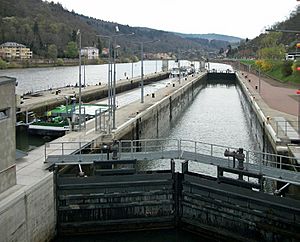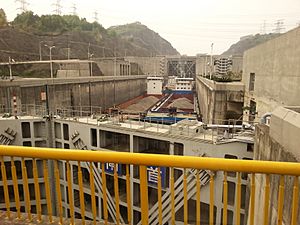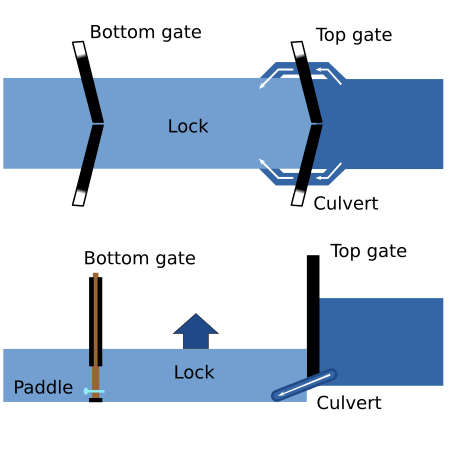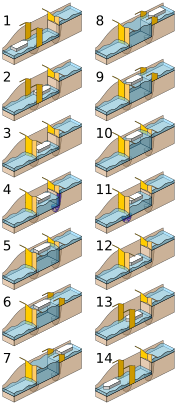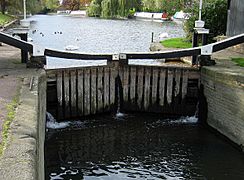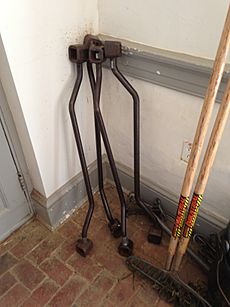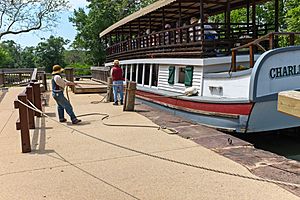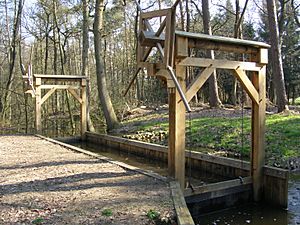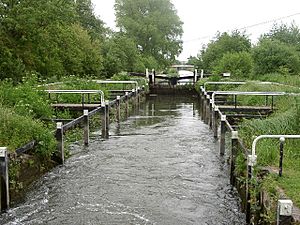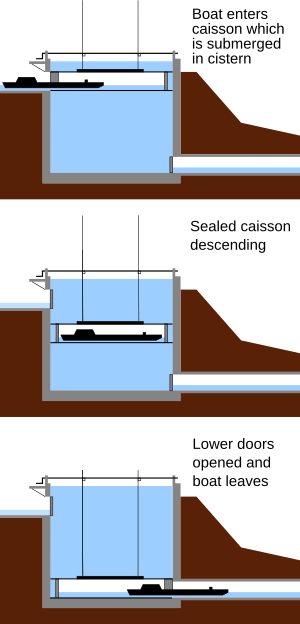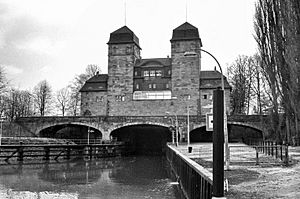Lock (water transport) facts for kids
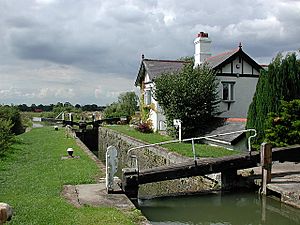
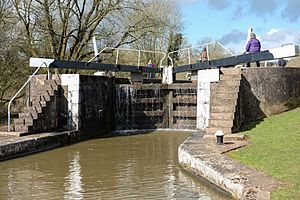
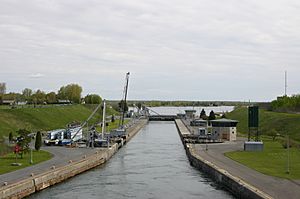
A lock is a special device used on rivers and canals. It helps boats and ships move between different water levels. Imagine a giant elevator for boats! Locks are a key part of waterways, making it possible for boats to travel uphill or downhill on water.
Locks are used to make a river easier to travel on. They also allow canals to cross land that isn't flat. Older canals used fewer locks, but modern canals often use many larger locks for more direct routes.
Contents
How a Pound Lock Works
The most common type of lock today is called a pound lock. It has a chamber with gates at both ends. These gates control the water level inside the chamber. An older design, called a flash lock, only had one gate.
Pound locks were first used in China during the Song Dynasty (960–1279 CE). A smart engineer named Qiao Weiyue invented them in 984. Before locks, boats had to use slipways, which caused many problems. The Chinese scholar Shen Kuo wrote about these locks in 1088.
He described them as having two gates about 50 paces apart. The whole area was covered by a roof. When the gates closed, water would build up. Then, it would be let out when needed. The water level could change by about 4 or 5 feet (1.2 to 1.5 meters) at each lock. On the Grand Canal, the water level was raised by 138 feet (42 meters) using these locks.
In Europe, a type of pound lock was built in 1373 in the Netherlands. The first true pound lock appeared in 1396 in Belgium. Later, an Italian engineer named Bertola da Novate built 18 pound locks in Milan between 1452 and 1458.
Parts and Operation of a Lock
Every pound lock has three main parts:
- A strong, waterproof chamber connects the upper and lower parts of the canal. This chamber is big enough for one or more boats. Its water level can change.
- A gate at each end of the chamber. These gates open to let boats in or out. When closed, they hold the water in.
- Lock gear to fill or empty the chamber. This is usually a simple valve. It lets water flow in or out. Bigger locks might use pumps.
Here’s how a lock works for a boat going downstream (downhill):
- First, the boat enters the lock. The lock is already full of water.
- Then, the entrance gates close behind the boat.
- Next, a valve opens. This lets water drain out of the chamber, lowering the boat.
- Finally, the exit gates open, and the boat moves out.
If the lock was empty, the boat would wait 5 to 10 minutes for it to fill. For a boat going upstream (uphill), the process is reversed. The boat enters an empty lock. Then, the chamber fills with water from the higher level. The whole process usually takes 10 to 20 minutes. This depends on the lock's size and if the water was already at the boat's level.
Boaters are often happy to see another boat coming towards them. This is because the other boat will have just used the lock. This means the lock will be set at their level, saving them time.
Lock Details and Terms
Rise
The rise is how much the water level changes in a lock. For example, Bath deep lock and Tuel Lane Lock in England have a rise of almost 20 feet (6 meters). These locks were made by combining two smaller locks. In Portugal, the Carrapatelo lock on the Douro river has a maximum lift of 115 feet (35 meters)!
Pound
A pound is the flat section of water between two locks. It's also called a reach.
Cill
The cill (or sill) is a narrow ledge inside the lock chamber. It's found just below the upper gates. It's important for boaters to know where the cill is. If the back of a boat gets caught on the cill while going down, it can be dangerous. The cill's edge is usually marked with a white line.
Photo gallery
-
Water saving gear on the Birmingham Canal Navigations.
Gates
Gates are the waterproof doors that seal the lock chamber. There's a gate (or a pair of half-gates) at each end. They were traditionally made of oak or elm wood. Today, they are often made of steel. The most common type, called miter gates, was invented by Leonardo da Vinci around the late 1400s.
Paddle
A paddle is a valve that controls the flow of water into or out of the lock chamber. On old canals, operating these paddles could be dangerous. Water pressure could make the handle spin violently, possibly injuring the operator.
Windlass ("lock key")
A windlass is a special crank or handle used to open and close the paddles. On some canals, lockkeepers had to remove the windlasses at night. This was to stop people from using the locks without permission.
Swell or Swelling
A swell is a surge of water. It happens when the paddle valves in the lock gates are opened quickly. This can help boats move out of a lock, especially if they are stuck. Sometimes, a boatsman would ask for a "back swell." This meant opening and closing the paddles a few times to create waves. This helped them get unstuck from the bank.
On the Erie Canal, some boats needed a swell to leave the lock. Lumber boats, for example, were top-heavy and could get stuck. However, canal managers didn't like swelling. It used too much water, which could lower the water level in the canal above. It could also raise the water level below, causing boats to hit bridges.
Snubbing Posts
Snubbing posts were used on canals with horse-drawn or mule-drawn boats. These posts helped slow or stop a boat in the lock. A heavy boat moving fast could easily damage the lock gate. To prevent this, a rope was wrapped around the snubbing post as the boat entered the lock. Pulling on the rope created friction, slowing the boat down.
In one incident in 1873, a boat crashed into and broke the downstream gates of a lock. This happened because the crew failed to use the snubbing post. The rush of water then broke the upstream gates too. This stopped all boat traffic for 48 hours!
Types of Locks
Composite Locks
To save money, especially where good stone was hard to find, composite locks were built. These locks used cheaper stone or rubble. Their inside walls were lined with wood. This protected the boats from rubbing against rough stone.
Powered Locks
On large, modern canals, the gates and paddles are too big to be moved by hand. They are operated by hydraulic or electric machines. On the Caledonian Canal, the lock gates were once moved by people using large cranks called capstans. By 1968, these were replaced by powerful hydraulic systems.
Fish Ladders
Locks and dams on rivers can block fish from moving upstream. Many fish, like salmon, need to swim upstream to lay their eggs. To help them, special structures called fish ladders are often built. These allow fish to bypass the locks and continue their journey.
Special Lock Designs
Doubled or Paired Locks
Sometimes, locks are built side by side on the same waterway. This is called doubling, pairing, or twinning. The Panama Canal has three sets of double locks. Having two locks next to each other helps boats move faster. It also means a small boat doesn't have to empty a large lock, saving water.
In some cases, the two locks can even help each other save water. Water from one emptying chamber can help fill the other. This is called "twinning."
Stop Locks
A stop lock was built when a new canal joined an older one. If the new canal's water level couldn't be guaranteed, the older company would build a stop lock. Its gates would point towards its own canal. This allowed them to close it if the new canal's water was low. This created two locks right next to each other, with gates pointing in opposite directions.
Round Locks
A round lock is a very unique type of lock. The most famous example is the Agde Round Lock on the Canal du Midi in France. This lock is round and has three gates. It allows boats to move along the main canal or enter the Hérault River.
Drop Locks
A drop lock is a special type of lock where both ends are at the same water level. It can only be emptied by draining water to a lower stream or by pumping water back up to the canal. The only drop lock ever built is at Dalmuir on the Forth and Clyde Canal in Scotland. It was built to allow a busy road bridge to be fixed, avoiding traffic delays.
Very Large Locks
Locks can be enormous! In 2016, the Kieldrecht Lock in Belgium became the world's largest lock by volume. In 2022, the IJmuiden sea lock in the Netherlands became the world's largest by size. It is 500 meters (1,640 feet) long and 70 meters (230 feet) wide.
The "fall" of a lock is how much the water level changes. The Bollène lock on the River Rhône has a fall of at least 23 meters (75 feet). The Oskemen Lock in Kazakhstan has an amazing drop of 42 meters (138 feet)!
History of Locks
Pound Lock History
The idea of a pound lock grew from earlier designs. As mentioned, pound locks were first used in China during the Song Dynasty (960–1279 CE). An official named Qiao Weiyue was tired of grain barges crashing on the West River. In 984, he built two gates 250 feet apart. This created a short section of canal, like a pound lock. Water could be let in from the top and out to the bottom.
Turf-sided Lock
A turf-sided lock is an old type of lock. Instead of brick or stone walls, it used earth banks. These banks would grow grass and other plants. Because the sides were sloped, these locks were wider when full. This meant they used more water than modern locks. Most turf-sided locks in Britain have been rebuilt with brick or stone. Only a few examples, like Monkey Marsh Lock, still exist.
Saving Water
Water Saving Basins
Some locks have special reservoirs called "side ponds" or "water saving basins." These ponds store water that is let out of the lock. This water can then be used to help fill the lock again later. This saves water and makes the canal system more efficient. The Droitwich Canal in England has locks with working side ponds.
Other Ways to Move Boats
Inclined Plane
An inclined plane is another way to move boats between different water levels. Instead of a lock, boats are placed in a cradle or caisson. This cradle is then pulled up or down a sloping track. The remains of a famous inclined plane can be seen at Foxton Locks in England. It was built to help wide boats bypass a series of ten narrow locks.
Caisson Lock
Around 1800, a man named Robert Weldon suggested using caisson locks. In this design, a boat enters a completely enclosed wooden box. This box then moves up and down in a deep pool of water. The water never leaves the chamber, so this type of lock wastes no water. One was built and shown to the Prince Regent, but it had some problems and wasn't widely used.
Shaft Lock
A shaft lock looks a bit like a caisson lock. It has a deep shaft with regular gates at the top. The lower gates are reached through a short tunnel. The shaft lock at Minden, Germany, has a fall of 12.7 meters (42 feet). It has eight tanks that help save water when the lock is emptied or filled.
Diagonal Lock

A diagonal lock is similar to a shaft lock, but the shaft is built on a slope. Boats are tied to floating posts that guide them as the shaft fills or empties. This new design is being considered for restoring canals and building new ones in Britain.
See also
 In Spanish: Esclusa para niños
In Spanish: Esclusa para niños
- Canal
- Water slope
- Sluice
- Hydraulics
- List of canals by country


